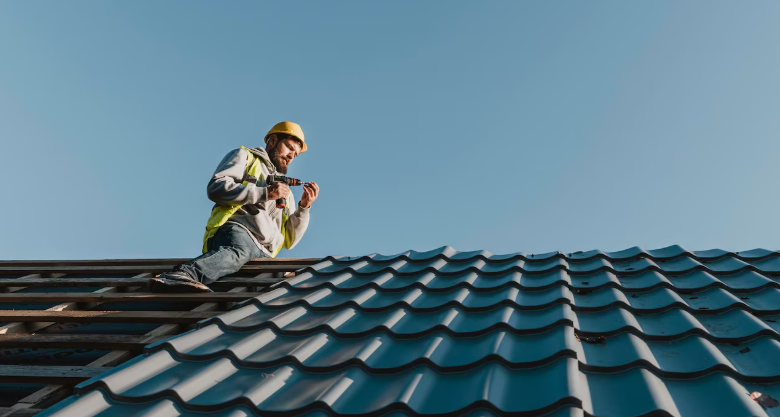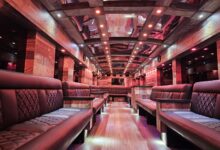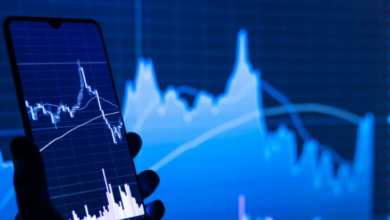Top Trends in Commercial Roofing Austin for 2025

Table of Contents
1. Cool Roofing Materials
Cool roofing materials are set to be a major trend in commercial roofing Austin for 2025. With Austin’s scorching summers, businesses are increasingly looking for ways to reduce energy consumption and lower cooling costs. Cool roofs achieve this by reflecting more sunlight and absorbing less heat than standard roofing materials. This can lead to significant savings on energy bills and a more comfortable indoor environment. When it comes to capital city roofing, this is a must.
There’s a growing demand for cool roofing options, and it’s not just about saving money. Many businesses are also motivated by environmental concerns, seeking to reduce their carbon footprint and contribute to a more sustainable future. Cool roofs can play a significant role in mitigating the urban heat island effect, which is a major issue in densely populated areas like Austin. Plus, some municipalities offer incentives or rebates for installing cool roofs, making them an even more attractive investment.
Choosing the right cool roofing material depends on several factors, including the building’s design, budget, and aesthetic preferences. Some popular options include:
- Reflective coatings
- Cool roofing membranes
- Specialized tiles
Cool roofing isn’t just a trend; it’s a smart, sustainable solution for businesses in hot climates. By reducing energy consumption and mitigating the urban heat island effect, cool roofs offer a win-win for both the bottom line and the environment. As energy costs continue to rise, expect to see even greater adoption of cool roofing materials in the years to come. And if you are looking for a metal roof Austin, make sure it has cool roofing properties.
2. Green Roof Systems
Green roofs are becoming a big deal, especially in places like Austin. I mean, who wouldn’t want a garden on their roof? It’s not just about looking pretty; there are real benefits to having one, especially when you consider the hot summers we get. More and more businesses are looking into this as a way to be more eco-friendly and save some money in the long run. Plus, it’s a great conversation starter!
Green roofs can significantly reduce stormwater runoff, which is a major plus for a city like Austin that deals with heavy rains.
Here’s a quick rundown of why they’re gaining traction:
- They help keep buildings cooler, which means less AC and lower energy bills.
- They can last longer than traditional roofs, so you’re not replacing them as often.
- They create a habitat for plants and insects, which is good for the environment.
I’ve been reading up on green roofs, and it’s amazing how much they can do. They’re not just a trend; they’re a smart investment for the future. It’s cool to see how capital city roofing and other companies are getting on board with this. It’s a win-win for everyone involved.
I’ve heard that some companies specializing in commercial roofing Austin are starting to offer maintenance packages specifically for green roofs. Makes sense, right? You need someone who knows what they’re doing to keep everything healthy and thriving. I wonder if they also do metal roof Austin installations with a green roof on top? That would be something!
3. Solar Panel Integration
Solar panel integration is becoming a big deal in commercial roofing Austin. More businesses are looking at solar to cut costs and be more eco-friendly. It’s not just about slapping some panels on a roof; it’s about making the roof and solar system work together efficiently. This trend is changing how capital city roofing companies approach new projects and renovations.
Integrating solar panels directly into the roofing system is becoming increasingly popular.
Here’s why solar is taking off:
- Lower energy bills: Solar power can significantly reduce a building’s electricity costs.
- Environmental benefits: Using solar energy reduces reliance on fossil fuels.
- Government incentives: Tax credits and rebates can make solar installations more affordable.
Solar panel integration is not just about adding panels to a roof; it’s about creating a unified system that maximizes energy production and roof longevity. This requires careful planning and expertise in both roofing and solar technologies.
For example, a metal roof Austin is a great base for solar panels because it lasts a long time and can handle the weight. Plus, metal reflects sunlight, which can boost the efficiency of the solar panels. It’s a win-win situation.
4. Energy-Efficient Insulation
When it comes to commercial roofing in Austin, energy-efficient insulation is becoming a big deal. It’s not just about keeping the building comfortable; it’s also about saving money on energy bills and reducing the environmental impact. With Austin’s hot summers, good insulation is a must-have for any business looking to cut costs and stay cool. Capital city roofing companies are really focusing on this.
There are several types of insulation materials available, each with its own set of benefits. From spray foam to rigid boards, the options can be overwhelming. Choosing the right one depends on factors like the building’s structure, climate, and budget. But investing in quality insulation is a smart move for any commercial property owner. Plus, a good metal roof Austin paired with proper insulation can make a huge difference in energy savings.
Upgrading your commercial roof’s insulation can significantly reduce energy consumption. By creating a thermal barrier, it minimizes heat transfer, keeping the building cooler in the summer and warmer in the winter. This not only lowers utility bills but also contributes to a more comfortable and productive work environment.
Here are some key benefits of energy-efficient insulation:
- Reduced energy consumption
- Lower utility bills
- Improved indoor comfort
- Extended lifespan of HVAC systems
- Increased property value
Energy-efficient insulation is a game-changer for commercial roofing Austin, offering long-term cost savings and environmental benefits.
5. Advanced Waterproofing Solutions
Waterproofing is obviously super important, especially with the crazy weather we get here in Austin. I mean, one minute it’s sunny, and the next, you’re dealing with a flash flood. For commercial roofing Austin, staying ahead of the game with waterproofing tech is a must. It’s not just about slapping on some sealant anymore; it’s about using materials and methods that really hold up over time.
Advanced waterproofing solutions are becoming increasingly vital for protecting commercial buildings from water damage, ensuring longevity and structural integrity.
Here’s what I’m seeing:
- Self-healing membranes that can automatically seal small punctures or cracks. Pretty cool, right?
- Liquid-applied waterproofing that creates a totally seamless barrier. No weak spots!
- Improved drainage systems to move water away from the roof faster and more efficiently. Think bigger gutters and smarter designs.
Waterproofing isn’t just about keeping the rain out. It’s about preventing moisture buildup that can lead to mold, rot, and all sorts of other problems. Investing in good waterproofing now can save you a ton of money and headaches down the road. Plus, it helps keep your building energy-efficient, which is always a good thing.
For capital city roofing, this means contractors need to be up-to-date on the latest products and techniques. And for building owners, it means being willing to invest in quality waterproofing, even if it costs a bit more upfront. Think of it as an investment in the long-term health of your building. Also, don’t forget about metal roof Austin, which, while durable, still needs proper waterproofing around seams and penetrations. It’s all connected!
6. Reflective Coatings
Reflective coatings are becoming a big deal in commercial roofing Austin, especially with the Texas heat. They’re designed to bounce sunlight away from the roof, which helps keep the building cooler. This can lead to lower energy bills because your AC doesn’t have to work as hard. Plus, it can extend the life of your roof by reducing the thermal stress it goes through every day. For capital city roofing, this is a no-brainer.
There are different types of reflective coatings, and the best one for you will depend on your specific needs and the type of roof you have. Some are better for metal roof Austin, while others work well on built-up roofs or modified bitumen. It’s worth doing some research or talking to a roofing pro to figure out what’s best.
Using reflective coatings is a simple way to make your building more energy-efficient and save money in the long run. It’s also a step towards more sustainable building practices, which is something more businesses are focusing on these days.
Here’s a quick look at some benefits:
- Reduced energy consumption
- Lower cooling costs
- Extended roof lifespan
- Improved indoor comfort
- Environmental benefits
7. Synthetic Roofing Membranes
Synthetic roofing membranes are becoming a big deal in commercial roofing Austin. They’re designed to be durable and long-lasting, which is exactly what businesses need. These membranes are engineered to withstand the crazy Texas weather, from scorching summers to the occasional hailstorm. Plus, they offer great protection against leaks, which can save a ton of money on repairs down the road. For capital city roofing projects, synthetic membranes are often a top choice because they’re reliable and can handle a lot of wear and tear.
One of the main reasons people are switching to synthetic membranes is their flexibility. They can be used on all sorts of roof shapes and sizes, making them perfect for different types of buildings. Installation is usually pretty straightforward, which can save time and labor costs. And because they’re lightweight, they don’t put as much stress on the building’s structure. This is especially important for older buildings that might not be able to handle heavy materials like some traditional roofing options. Synthetic roofing membranes are a solid choice for anyone looking for a dependable and adaptable roofing solution.
Synthetic roofing membranes are a great option for commercial buildings because they are durable, flexible, and easy to install. They provide excellent protection against the elements and can help reduce energy costs.
Here’s a quick look at some common types:
- TPO (Thermoplastic Olefin): Known for its heat resistance and energy efficiency.
- PVC (Polyvinyl Chloride): Offers excellent chemical resistance and durability.
- EPDM (Ethylene Propylene Diene Monomer): A rubber-like material that’s very flexible and weather-resistant.
Choosing the right type depends on the specific needs of your building and the climate in Austin. For example, if you have a building with a lot of chemical exposure, PVC might be the best bet. If you’re more concerned about energy efficiency, TPO could be a better choice. And for buildings that need a lot of flexibility, EPDM is a great option. It’s always a good idea to talk to a roofing professional to figure out what’s best for your situation. Especially when considering a metal roof Austin, the membrane underneath plays a big role in longevity.
8. Metal Roofing Innovations
Metal roofing is getting a serious upgrade, and it’s not just about the look. We’re seeing some cool advancements that are making metal a top choice for commercial roofing Austin projects. It’s a big deal for capital city roofing because these innovations mean better performance and longer lifespans for roofs. Plus, with the Texas weather, a good metal roof Austin can really make a difference.
- Improved coatings for better reflectivity and durability.
- New installation techniques that reduce labor costs.
- More variety in colors and styles to match any building design.
Metal roofing is no longer just about function; it’s about aesthetics and sustainability too. The new innovations are making it easier to integrate metal roofs into modern building designs while also improving energy efficiency.
The latest metal roofing systems are designed to withstand extreme weather conditions, making them a smart investment for businesses.
9. Drones for Roof Inspections
Drones are becoming a pretty common sight in the commercial roofing Austin scene, especially when it comes to inspections. It’s a trend that’s only going to get bigger in 2025. Instead of someone climbing up there and risking a fall, or spending hours trying to spot every little issue, a drone can zip around and get a detailed look in minutes. This is especially useful for large commercial buildings or those with complex roof designs.
Drones equipped with high-resolution cameras and even thermal imaging can identify problems like leaks, damaged flashing, or areas of poor insulation much faster and more accurately than traditional methods.
Think about it: a capital city roofing company can use drones to quickly assess the condition of a roof after a storm, providing clients with immediate feedback and estimates for repairs. Plus, the detailed imagery can be used for documentation and insurance claims. For metal roof Austin projects, drones can help ensure proper installation and identify any potential issues early on, saving time and money in the long run.
Using drones for roof inspections isn’t just about convenience; it’s about safety and efficiency. It reduces the risk of accidents, provides more thorough inspections, and ultimately helps building owners make informed decisions about their roof maintenance and repairs.
Here’s a quick look at some of the benefits:
- Faster inspection times
- Improved safety for inspectors
- More detailed and accurate assessments
- Cost savings on labor and equipment
- Better documentation for maintenance and repairs
10. Smart Roofing Technology
Smart roofing tech is becoming a big deal, especially in places like Austin where the weather can be so unpredictable. It’s all about using sensors and data to make roofs more efficient and long-lasting. I’ve been reading up on it, and it’s pretty interesting how much technology is changing the game for commercial roofing Austin and even residential roofs. It’s not just about slapping some shingles up there anymore; it’s about creating a system that can monitor itself and adapt to different conditions. For example, “capital city roofing” companies are starting to use these technologies to offer better service.
One of the coolest things is how these systems can help you save money. By monitoring things like temperature and moisture, they can help you optimize your energy use and prevent costly repairs down the line. Plus, with the rise of metal roof Austin options, integrating smart tech can really maximize the lifespan and performance of your roof. It’s like giving your roof a brain!
Smart roofing technology is changing how we think about roofs. It’s not just about protection from the elements anymore; it’s about creating a smart, efficient, and sustainable system that can adapt to changing conditions and help you save money. It’s a big investment upfront, but the long-term benefits are hard to ignore.
Here are some of the key benefits:
- Early Problem Detection: Sensors can catch leaks or damage before they become major issues.
- Energy Efficiency: Smart systems can optimize insulation and ventilation to reduce energy costs.
- Remote Monitoring: You can keep an eye on your roof’s condition from anywhere with an internet connection.
I think we’ll see more and more of this in the coming years. It’s not just a trend; it’s a smarter way to build and maintain roofs.
11. Sustainable Roofing Practices
Okay, so sustainable roofing is a big deal, especially here in Austin. It’s not just a trend; it’s about making smart choices for the environment and your wallet. When we talk about sustainable practices in commercial roofing Austin, we’re looking at materials and methods that reduce environmental impact, conserve energy, and promote long-term durability. It’s about thinking beyond the initial cost and considering the lifecycle of the roof.
One thing I’ve noticed is that more businesses are asking about options that align with their sustainability goals. They want to know about the environmental footprint of the materials, how the installation process affects the surrounding area, and what happens to the roof at the end of its life. It’s a holistic approach, and it’s changing the way capital city roofing is done.
Sustainable roofing practices are becoming increasingly important as businesses and building owners seek to reduce their environmental impact and lower operating costs. This includes selecting materials with recycled content, implementing energy-efficient designs, and adopting responsible disposal methods.
Here are some key aspects of sustainable roofing practices:
- Material Selection: Choosing materials with recycled content or those that are locally sourced reduces transportation emissions and supports local economies.
- Energy Efficiency: Implementing designs that minimize energy consumption, such as cool roofs or green roofs, can significantly lower utility bills.
- Waste Reduction: Adopting responsible disposal methods, such as recycling old roofing materials, helps to minimize landfill waste.
For example, a metal roof Austin can be a sustainable choice because metal is highly recyclable and can last for decades. Plus, metal roofs can reflect sunlight, reducing the need for air conditioning in the summer. It’s a win-win situation.
12. Lightweight Roofing Options
Lightweight roofing is becoming a big deal, especially in areas like Austin where the heat can really put a strain on buildings. It’s all about finding materials that don’t weigh down the structure too much, which can save money on construction and even help with energy bills. For commercial roofing Austin projects, this is something more and more people are asking about.
There are a bunch of reasons why lightweight roofing is catching on. For one, it can make installation easier and faster. Plus, it’s a good option for older buildings that might not be able to handle the weight of traditional roofing materials. And let’s not forget about the potential for lower cooling costs – lighter materials often reflect more sunlight, keeping the building cooler. When you’re thinking about capital city roofing, you’ve got to consider the long-term benefits, and lightweight options definitely bring some to the table. Also, if you are looking for a metal roof Austin, there are some very light options available.
13. Modular Roofing Systems
Modular roofing systems are gaining traction in commercial roofing Austin, offering a blend of speed, efficiency, and design flexibility. These systems involve pre-engineered roofing components manufactured off-site and then assembled on the building. It’s like building with LEGOs, but for your roof! This approach can significantly reduce installation time and minimize disruption to business operations. For capital city roofing projects, modular systems present an attractive option for quick turnarounds and consistent quality.
Here’s why modular roofing is becoming a favorite:
- Faster Installation: Modules are built in a controlled environment, leading to quicker on-site assembly.
- Reduced Waste: Precise manufacturing minimizes material waste, contributing to sustainable building practices.
- Design Flexibility: Modular systems can accommodate various roof shapes and architectural styles.
Modular roofing can be a game-changer, especially when you’re looking at a metal roof Austin. The precision and speed of installation can really cut down on project timelines. Plus, the reduced waste is a big win for sustainability.
Modular roofing systems are particularly beneficial for projects with tight deadlines or complex designs. The ability to pre-fabricate components ensures consistent quality and reduces the impact of weather delays on the construction schedule.
Think about it: less time spent on installation means less disruption to your business. That’s a pretty big deal!
14. Roof Garden Installations
Roof garden installations are becoming a popular trend in commercial roofing Austin, especially for businesses looking to add an aesthetic touch and improve their environmental footprint. It’s more than just throwing some plants on a roof; it’s about creating a functional ecosystem that can benefit the building and its occupants. These installations can range from simple green roofs with sedum to more elaborate setups with trees and seating areas. For capital city roofing projects, this is a trend that’s gaining traction.
- Improved insulation, which can lead to lower energy bills.
- Enhanced stormwater management, reducing runoff.
- Increased property value and aesthetic appeal.
Roof gardens can significantly reduce the urban heat island effect, making the surrounding area cooler. They also provide habitats for birds and insects, contributing to biodiversity in the city. Plus, they offer a relaxing space for employees or residents.
For a metal roof Austin, the structural integrity is key when considering a roof garden. You need to ensure the roof can handle the added weight of the soil, plants, and water. Regular maintenance is also important to keep the garden healthy and prevent any damage to the roofing system. Proper planning and installation are essential for a successful roof garden.
15. High-Performance Shingles
Okay, so high-performance shingles are becoming a big deal, especially in places like Austin where the weather can be pretty intense. We’re talking about shingles that go above and beyond the standard stuff you see on most roofs. These are designed to last longer, withstand extreme conditions, and generally give you more bang for your buck. For commercial roofing Austin projects, this is a trend that’s really picking up steam.
These shingles are engineered to provide superior protection and longevity compared to traditional options.
Think about it – the initial cost might be a bit higher, but if you’re not replacing your roof as often, you’re saving money in the long run. Plus, you’re dealing with less hassle and disruption. And for businesses, that’s a huge win.
Here’s a quick rundown of why people are choosing these shingles:
- Extended Lifespan: They’re built to last, often with warranties that reflect that.
- Weather Resistance: Hail, wind, intense sun – they can handle it.
- Energy Efficiency: Some even help reduce your energy bills by reflecting sunlight.
Investing in high-performance shingles is a smart move for any business owner looking to protect their property and reduce long-term costs. It’s about making a choice that benefits both your wallet and the environment.
And let’s not forget about the aesthetic appeal. High-performance shingles often come in a wider range of styles and colors, so you can really customize the look of your building. For capital city roofing projects, this is a great way to stand out and make a statement. Plus, if you’re considering a metal roof Austin, high-performance shingles can offer a similar level of durability with a different aesthetic.
16. Recycled Roofing Materials
Okay, so recycled roofing materials are becoming a bigger deal, especially here in Austin. With more focus on sustainability, people are looking for ways to reduce waste and use resources more responsibly. It’s not just a trend; it’s about making smarter choices for the environment and, honestly, for your wallet in the long run. Plus, with all the construction going on in the capital city roofing sector, finding sustainable options is more important than ever.
Using recycled materials in commercial roofing Austin projects can significantly lower the environmental impact of construction.
There are a few reasons why this is catching on:
- It reduces landfill waste.
- It conserves natural resources.
- It can sometimes be more cost-effective.
I think the biggest thing is that people are starting to see the value in these materials. They’re not just some cheap alternative; they can be really durable and long-lasting. It’s about changing the mindset and seeing recycled materials as a smart investment.
For example, you can find shingles made from recycled plastics or metal roofing that incorporates recycled steel. Even some insulation materials are made from recycled content. It’s pretty cool when you think about it. And for those considering a metal roof Austin, there are options with high recycled content, which is a win-win.
Here’s a quick look at some common recycled roofing materials:
| Material | Recycled Content | Benefits |
| Recycled Shingles | 30-95% | Cost-effective, reduces waste |
| Recycled Metal | 25-100% | Durable, long-lasting, energy-efficient |
| Recycled Plastic | 50-90% | Lightweight, waterproof, versatile |
17. Seamless Roofing Systems
Seamless roofing systems are gaining traction in the commercial roofing Austin scene, and for good reason. They offer a continuous, watertight barrier that minimizes the risk of leaks and water damage. Think about it – fewer seams mean fewer potential points of failure. For capital city roofing projects, this is a big deal, especially with Austin’s unpredictable weather patterns.
These systems are typically applied as a liquid and then cure to form a solid, monolithic membrane.
Here’s why seamless roofing is becoming a favorite:
- Reduced Leak Potential: With no seams, there’s less chance of water seeping through.
- Durability: These systems can withstand harsh weather conditions and temperature fluctuations.
- Easy Application: They can be applied over existing roofs, saving time and money on tear-off.
- Long Lifespan: Seamless roofs often come with extended warranties, reflecting their longevity.
Seamless roofing is a great option for buildings that need a reliable, long-lasting roof. It’s an investment that can pay off in the long run by preventing costly repairs and extending the life of the building. Plus, it’s a good way to improve the energy efficiency of your building, which can save you money on your utility bills.
For businesses considering a metal roof Austin, seamless roofing can be a complementary solution, especially for low-slope or flat roofs where water ponding is a concern. It’s all about finding the right fit for your specific needs and building structure.
18. Roof Maintenance Software
Okay, so roof maintenance software might not sound like the most exciting thing in the world, but trust me, for commercial roofing Austin, it’s becoming a pretty big deal. Think about it: managing multiple properties, keeping track of inspections, and scheduling repairs can quickly turn into a logistical nightmare. That’s where these software solutions come in. They’re designed to streamline everything, making it easier for property managers and capital city roofing companies to stay on top of things.
Roof maintenance software is changing how businesses manage their roofing assets.
Here’s why I think it’s a trend that’s going to stick around:
- Improved organization: No more sifting through piles of paperwork or endless spreadsheets. Everything is digital and easily accessible.
- Better communication: Software can facilitate communication between property owners, roofing contractors, and tenants.
- Preventative maintenance: These tools help schedule regular inspections and maintenance, preventing small issues from becoming major (and expensive) problems. Especially important for a metal roof Austin.
I’ve heard from a few folks in the industry that using roof maintenance software has significantly reduced their operational costs. It’s not just about saving time; it’s about preventing costly repairs down the line by catching problems early. Plus, having all the data in one place makes it easier to make informed decisions about roof replacements or upgrades.
I think it’s a trend that’s going to keep growing as more businesses realize the benefits. It’s all about working smarter, not harder, and these software solutions definitely help with that.
19. Building-Integrated Photovoltaics
Building-Integrated Photovoltaics (BIPV) are becoming a bigger deal in commercial roofing Austin. Instead of just slapping solar panels on top of a roof, BIPV actually replaces standard roofing materials with solar-generating ones. It’s a pretty neat concept, and it’s gaining traction because it can save space and look better than traditional solar setups. Plus, it helps buildings meet sustainability goals.
BIPV is a growing trend in capital city roofing, especially for new construction or major renovations. It’s not just about generating electricity; it’s about integrating that generation into the building’s design. Think solar shingles, solar tiles, and even solar glass. It’s all about making the building itself a power plant. And with the focus on renewable energy, it’s likely we’ll see more of this in the future, especially with metal roof Austin options.
BIPV systems can be a significant upfront investment, but they often pay for themselves over time through reduced energy costs and potential government incentives. It’s a long-term play that aligns with sustainability efforts and can increase a building’s value.
Here’s a quick look at some of the benefits:
- Reduced energy costs
- Aesthetically pleasing design
- Increased property value
- Environmentally friendly
And here’s a table comparing BIPV to traditional solar panels:
| Feature | BIPV | Traditional Solar Panels |
| Integration | Integrated into building materials | Mounted on existing roof |
| Aesthetics | More visually appealing | Can be bulky and less attractive |
| Cost | Higher upfront cost | Lower upfront cost |
| Space Utilization | Replaces roofing materials | Requires additional roof space |
BIPV is expected to become more common as technology improves and costs decrease.
20. Enhanced Drainage Solutions
Okay, so when we talk about commercial roofing Austin, we can’t forget about water. I mean, it rains here, right? A lot. So, enhanced drainage solutions are becoming a big deal. It’s not just about slapping a gutter on and calling it a day. We’re talking about systems designed to handle serious downpours and prevent water from wreaking havoc on your building. Think about it – a leaky roof can lead to mold, structural damage, and a whole host of other problems.
Proper drainage is key to extending the life of your roof and protecting your investment.
Here’s the thing: older buildings often have outdated drainage systems that just can’t keep up with modern rainfall patterns. And new construction? Well, you want to get it right from the start. That’s where these enhanced solutions come in. They’re designed to efficiently move water away from the roof and foundation, preventing pooling and potential damage. Plus, they can even help with water conservation efforts.
Investing in better drainage now can save you a ton of money and headaches down the road. It’s all about being proactive and thinking long-term. Don’t wait until you have a major leak to address your drainage issues.
Here are some things to consider:
- Material Matters: Choosing the right materials for your gutters and downspouts is important. Metal, like what you’d find in a metal roof Austin, is durable, but there are other options too.
- Regular Maintenance: Even the best drainage system needs regular cleaning and maintenance to function properly. Clogged gutters can lead to serious problems.
- Professional Installation: Don’t try to DIY this. Get a qualified capital city roofing contractor to install your drainage system. They’ll know how to properly size and position everything for optimal performance.
So, yeah, enhanced drainage solutions are definitely something to keep an eye on in the commercial roofing Austin scene. It’s all about protecting your building from the elements and ensuring it stays in good shape for years to come.
21. Fire-Resistant Roofing Products
Okay, so fire-resistant roofing is a big deal, especially with how unpredictable the weather’s been. I mean, who wants to worry about their roof going up in flames? Not me, that’s for sure. And it’s not just about homes; for commercial roofing Austin, it’s practically a must-have.
There are different levels of fire resistance, usually rated Class A, B, or C, with A being the best. Class A materials can withstand severe fire exposure, which is what you want for peace of mind. Think about it – a good roof can really protect everything underneath.
For example, a metal roof Austin is a great option. It’s durable and can last for years, plus it offers excellent fire protection. It’s a bit of an investment upfront, but when you consider the long-term benefits, it’s totally worth it. Plus, it looks pretty sharp, if you ask me.
Choosing the right fire-resistant roofing material is more than just about safety; it’s about protecting your investment and ensuring the well-being of everyone inside. It’s a decision that can save you a lot of headaches down the road.
Here’s a quick rundown of some popular fire-resistant materials:
- Metal Roofing: As mentioned, great fire resistance and longevity.
- Tile Roofing: Clay or concrete tiles are naturally fire-resistant.
- Asphalt Shingles (certain types): Look for shingles with a Class A fire rating.
And don’t forget about proper installation. Even the best materials won’t do much good if they’re not installed correctly. Always hire a qualified contractor, especially for something as important as fire protection. For capital city roofing, you want someone who knows their stuff and can ensure your roof is up to code and ready to withstand whatever comes its way.
22. Noise-Reducing Roofing Materials
Living in a busy city like Austin, noise pollution is a real concern, especially for commercial buildings. That’s why noise-reducing roofing materials are becoming increasingly popular in the commercial roofing Austin scene. These materials help create a quieter, more comfortable environment inside the building, which is great for productivity and overall well-being. Think about it – a quieter office means fewer distractions and happier employees. For capital city roofing, this is a big deal.
There are several ways roofing materials can reduce noise. Some materials are naturally better at absorbing sound waves, while others are designed with special layers or coatings to dampen noise. The type of material you choose will depend on your specific needs and budget, but the benefits of a quieter building are hard to ignore. Plus, with the increasing focus on sustainability, many noise-reducing materials are also eco-friendly, making them a win-win for businesses.
For example, a metal roof Austin can be treated to reduce noise. It’s not just about slapping on any old roof; it’s about making smart choices that improve the quality of life for everyone inside the building.
Noise-reducing roofing materials are a smart investment for any business looking to improve its environment. They not only reduce noise pollution but also contribute to a more sustainable and comfortable workspace. This can lead to increased productivity and a better overall experience for employees and customers alike.
23. Customizable Roofing Designs
Customizable roofing designs are becoming a big deal, especially in commercial roofing Austin. People want their buildings to stand out, and the roof is a great place to do it. It’s not just about looks, though; customization can also mean better performance and longevity. Think about it – a roof tailored to your specific needs and aesthetic preferences? That’s where things are headed.
The ability to tailor a roof’s design to specific architectural styles and functional requirements is increasingly valued.
Here’s what’s driving this trend:
- Aesthetic Appeal: Businesses want roofs that reflect their brand and create a unique visual identity.
- Performance Needs: Custom designs can optimize for energy efficiency, drainage, and other specific requirements.
- Property Value: A well-designed, unique roof can significantly increase a building’s market value.
Customization in roofing isn’t just about making things look pretty. It’s about creating a roofing system that perfectly fits the building’s needs, climate, and the owner’s vision. It’s about integrating form and function in a way that maximizes value and performance. This is especially important for capital city roofing projects where aesthetics and durability are paramount.
For example, a metal roof Austin can be customized with different colors, textures, and panel orientations to achieve a specific look. The possibilities are pretty endless.
24. Biodegradable Roofing Options
Okay, so biodegradable roofing is becoming a bigger deal, especially with more focus on sustainability. It’s not just a trend; it’s about making choices that are better for the planet. For commercial roofing Austin, this could mean a shift towards materials that break down naturally over time, reducing waste and environmental impact. It’s something capital city roofing companies are starting to explore more seriously.
Think about it: traditional roofing materials can sit in landfills for ages. Biodegradable options, on the other hand, return to the earth. It’s a pretty cool concept, and it aligns with the growing demand for eco-friendly building practices. Plus, it could give your building a unique selling point.
Here are some things to consider about biodegradable roofing:
- Material Types: Options include things like wood shakes, thatch, and even some newer plant-based composites. Each has its own lifespan and maintenance needs.
- Cost Factors: Initially, biodegradable materials might be a bit pricier than conventional ones. However, consider the long-term benefits, like reduced disposal costs and potential tax incentives for green building.
- Climate Suitability: Austin’s weather can be intense. It’s important to choose biodegradable materials that can withstand the heat, humidity, and occasional storms. A metal roof Austin might still be a better bet for some buildings, but it’s worth exploring the biodegradable alternatives.
Biodegradable roofing isn’t just about being eco-friendly; it’s about rethinking the entire lifecycle of a roof. It’s about choosing materials that minimize environmental impact from production to disposal. This approach can lead to a more sustainable and responsible building design.
It’s not a perfect solution for every situation, but it’s definitely something to keep an eye on as technology advances and more options become available. The future of roofing might just be a lot greener than we think.
25. Advanced Ventilation Systems and more
Proper ventilation is super important for any building, especially in a place like Austin. With the hot summers, making sure air flows correctly can save a lot on energy bills and keep the building in good shape. When you’re thinking about commercial roofing Austin, don’t forget about how ventilation plays a big role in the overall health of the roof and the building itself.
Advanced ventilation systems are becoming more common because they help regulate temperature and moisture, preventing issues like mold and structural damage.
There’s more to consider than just ventilation, though. Things like regular inspections, using quality materials, and keeping up with maintenance are all part of the bigger picture. For example, if you’re considering a metal roof Austin, make sure the installation includes proper ventilation to avoid condensation problems. Capital city roofing projects need to think about the long-term benefits of a well-ventilated roof.
- Improved air quality
- Reduced energy costs
- Extended roof lifespan
It’s easy to overlook ventilation when planning a roofing project, but it’s a key factor in preventing problems down the road. A good ventilation system can make a big difference in the comfort and longevity of your building. Don’t skimp on this aspect; it’s worth the investment.
And more? Well, that includes things like regular inspections, using quality materials, and keeping up with maintenance. All of these are part of the bigger picture. For example, if you’re considering a metal roof Austin, make sure the installation includes proper ventilation to avoid condensation problems. Capital city roofing projects need to think about the long-term benefits of a well-ventilated roof.
Wrapping It Up
So, there you have it. The commercial roofing scene in Austin is changing fast, and 2025 is shaping up to be a big year. From eco-friendly materials to smart roofing tech, businesses are really stepping up their game. If you’re in the market for a new roof or just curious about what’s out there, keep these trends in mind. They could save you money and help the environment at the same time. It’s all about staying ahead of the curve, right? Whether you’re a business owner or just someone interested in roofs, these trends are worth watching. Let’s see how they play out!
Meta Description
Explore the top trends in commercial roofing Austin for 2025, from cool materials to smart technology.






